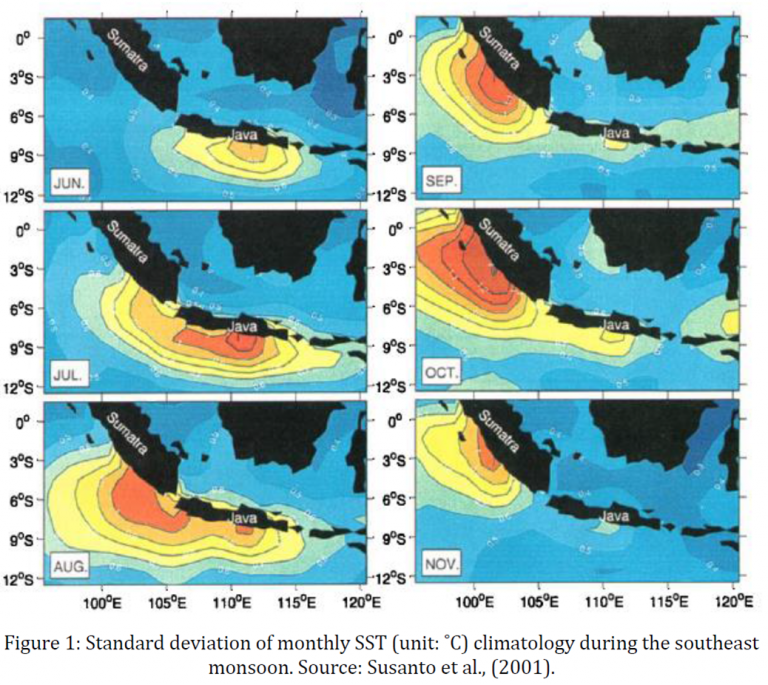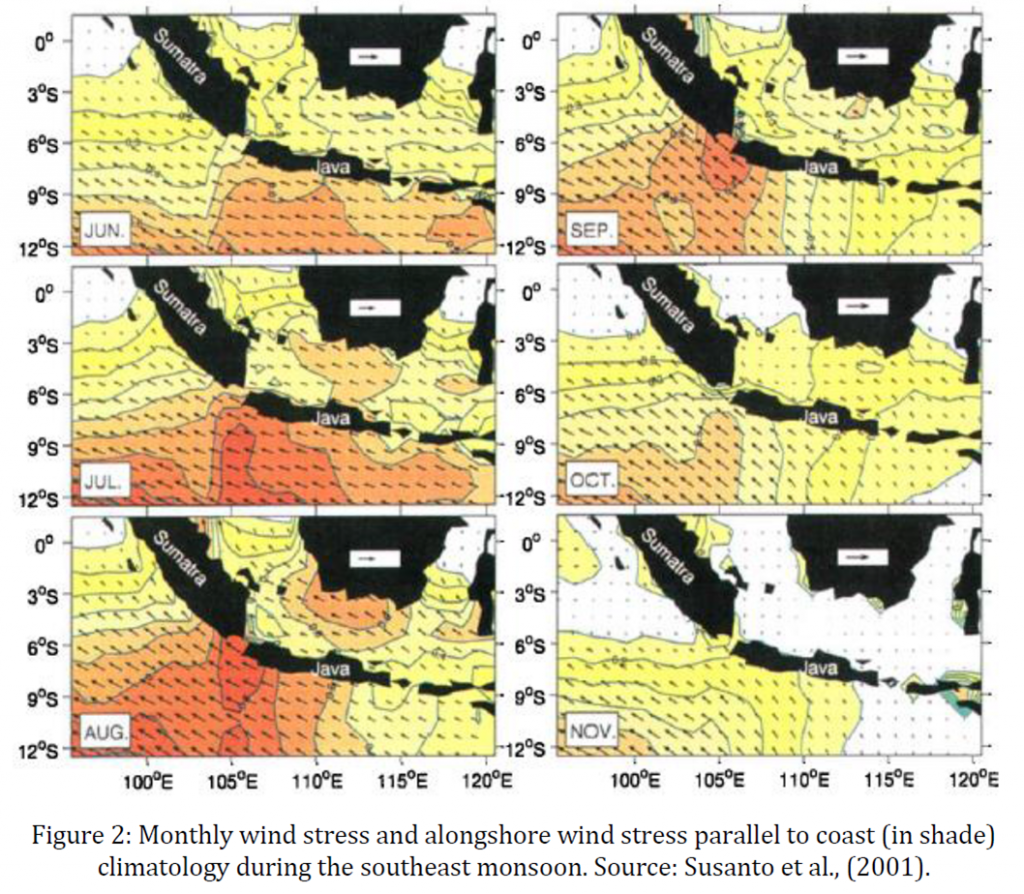Upwelling Along the Java-Sumatra Coast
The southeasterly wind blowing from Australia during the southeast monsoon promotes upwelling along the coasts of Java and Sumatra (Susanto et al., 2001). The upwelling area along the coast of Java is often associated with low sea surface temperature (SST) and high chlorophyll concentration, which promotes high primary productivity in the region (Asanuma et al., 2003; Lahlali et al., 2018; Susanto et al., 2006). The active upwelling region is represented by the presence of cooler waters between the coasts of Java and Sumatra, with monthly temporal and spatial shifts during the southeast monsoon between June and November (Figure 1) (Susanto et al., 2001). The upwelling evolution in this region correlates well to the evolution of the prevailing wind along the coasts Java-Sumatra during the southeast monsoon (Qu et al., 2005; Susanto et al., 2001) (Figure 2). At the beginning of the southeast monsoon, the easterly alongshore wind in the southeastern tropical Indian Ocean are rising stronger. In June, the alongshore wind increased further and reached its peak in July and August around 105 ˚E, wich contributed to upwelling along the east coast of Java. The centre of upwelling moves northwest continuously and reaches 2 ˚S and 100 ˚E in October, while the highest parallel wind to the coast is located at the tip of the Sumatera coast. In November, the weakening of the alongshore wind led to a fall in upwelling (Susanto et al., 2001). Along the coast of Java, the alongshore wind shift is responsible for the westward shift of the upwelling centre along the coast of Java. Nonetheless, the alongshore wind and the latitudinal changes of the Coriolis parameter along the Sumatra coast are responsible for northwest shift of the upwelling centre (Susanto et al., 2001). The above findings indicated that offshore Ekman transport due to the alongshore wind is primary factor in inducing upwelling along the coasts of Sumatra and Java (Iskandar et al., 2009; Susanto et al., 2001; Susanto and Marra, 2005). Nonetheless, a study by Wirasatriya et al. (2020) suggested that Ekman pumping due to wind stress curl in the eastern part of the coast of Java is significant in inducing upwelling.


The inter-annual variability of upwelling along the coasts of Java and Sumatra is modulated by El Niño Southern Oscillation (ENSO) and Indian Ocean Dipole (IOD). In El Niño, the Indonesian throughflow (ITF) provides cooler water that shallows the thermocline depth and the presence of stronger easterly winds that supress coastally trapped waves causes upwelling to intensify. However, during La Niña, the ITF brings warmer water, deepening the thermocline and contributing to the weakening of the upwelling intensity (Susanto et al., 2001). In addition, the present of positive IOD generates anomalous strong southeasterly alongshore wind along the coasts of Java and Sumatra, leading to a rise in upwelling (Horii et al., 2018; Iskandar et al., 2009; Murtugudde et al., 1999; Susanto and Marra, 2005). The combination of ENSO and IOD also contributes to an interannual variability of upwelling along the coasts of Java and Sumatra. The study conducted by Wirasatriya et al. (2020) suggested that the combination effect of La Niña and negative IOD weakens the upwelling intensity, reduce the concentration of chlorophyll and reduce the cooling of SST during the upwelling period.
References
Asanuma, I., Matsumoto, K., Okano, H., Kawano, T., Hendiarti, N., Sachoemar, S.I., 2003. Spatial distribution of phytoplankton along the Sunda Islands: The monsoon anomaly in 1998. J. Geophys. Res. 108. https://doi.org/10.1029/1999JC000139
Horii, T., Ueki, I., Ando, K., 2018. Coastal upwelling events along the southern coast of Java during the 2008 positive Indian Ocean Dipole. J. Oceanogr. 74, 499–508. https://doi.org/10.1007/s10872-018-0475-z
Iskandar, I., Rao, S.A., Tozuka, T., 2009. Chlorophyll‐a bloom along the southern coasts of Java and Sumatra during 2006. Int. J. Remote Sens. 30, 663–671. https://doi.org/10.1080/01431160802372309
Lahlali, H., Wirasatriya, A., Gensac, E., Helmi, M., Kunarso, Kismawardhani, R.A., 2018. Environmental aspects of tuna catches in the Indian Ocean, southern coast of Java, based on satellite measurements, in: 2018 4th International Symposium on Geoinformatics (ISyG). IEEE. https://doi.org/10.1109/ISYG.2018.8612020
Murtugudde, R.G., Signorini, S.R., Christian, J.R., Busalacchi, A.J., McClain, C.R., Picaut, J., 1999. Ocean color variability of the tropical Indo-Pacific basin observed by SeaWiFS during 1997-1998. J. Geophys. Res. Ocean. 104, 18351–18366. https://doi.org/10.1029/1999JC900135
Qu, T., Du, Y., Stachan, J., Meyers, G., Slingo, J., 2005. Sea surface temperature and its variability in the Indonesian region. Oceanography 18, 50–61. https://doi.org/10.5670/oceanog.2005.05
Susanto, R.D., Gordon, A.L., Zheng, Q., 2001. Upwelling along the coasts of Java and Sumatra and its relation to ENSO. Geophys. Res. Lett. 28, 1599–1602. https://doi.org/10.1029/2000GL011844
Susanto, R.D., Marra, J., 2005. Effect of the 1997/98 El Niño on chlorophyll a variability along the southern coasts of Java and Sumatra. Oceanography 18, 124–127. https://doi.org/10.5670/oceanog.2005.13
Susanto, R.D., Moore, T.S., Marra, J., 2006. Ocean color variability in the Indonesian Seas during the SeaWiFS era. Geochemistry, Geophys. Geosystems 7. https://doi.org/10.1029/2005GC001009
Wirasatriya, A., Setiawan, J.D., Sugianto, D.N., Rosyadi, I.A., Haryadi, H., Winarso, G., Setiawan, R.Y., Susanto, R.D., 2020. Ekman dynamics variability along the southern coast of Java revealed by satellite data. Int. J. Remote Sens. 41, 8475–8496. https://doi.org/10.1080/01431161.2020.1797215
